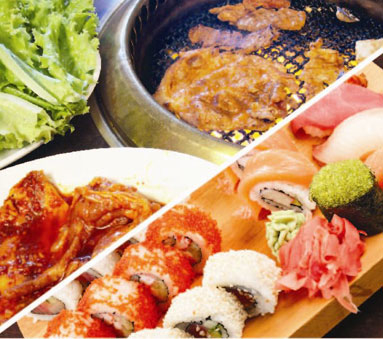
Japanese vs South Korea: Story of Cuisine
Japanese vs South Korea: Story of Cuisine
These two kind of cuisine has many similarities, of which the main themes are wrapped and rolled style. However, each of them has its own meaning and cultural symbolism pointing to its origin.
If Japan is famous for sushi and sashimi, Korean’s BBQ is a very popular food having been achieved rapid popularity in recent years. To enjoy these special foods as much as a local citizen and to have a unique and enjoyable experience in Japanese and South Korean restaurants, you should learn about cultures and the fundamental principles of these two cultures’ typical cuisine.
Japan is a country of complex and formal rituals and obviously they are diligent and thorough to culinary preparation. Japanese cuisine has many great delicacies such as Sushi, Sashimi and Nikogori. During meal time, Japanese always focuses on the importance of enjoying art and not simply taste the food. Therefore, when starting a meal, we should remember to speak out “itadakimasu” (which means “let’s start the meal”) and said “gochisosama deshita” (which means “this is a great party”) to the chefs and restaurant staffs to show your gratitude for services.
When you eat, you should not set chopsticks along the bowl because this is the ritual only for the dead, do not use chopsticks to pin the food, point at others or pass food to another pair of chopsticks. When you want to treat someone, you have to pick it up directly from the disk and pass it to him. In particular, you should not leave the leftovers on the table and ask the chef to serves courses other than the dishes in the menu.
In addition to the above rituals, eating sushi in a proper way is something that you need to consider when coming to Japan. The waiter will bring you a oshibori (hot towel) as soon as you have your seat at the table so that you can wipe your hands before starting the meal. Chopsticks are normally attached at one end, you should separate them vertically. Do not rub the chopsticks because it meant to offend the restaurants. Actually, you can eat sushi by hand or with chopsticks. You should not dip the sushi roll into soy sauce. If the sushi was decorated with sauce on it, then you do not need to use the soy sauce again.
Korean cuisine is relatively different from other Asian cuisines, they will cause you a little inconvenience if this is your first visit to a barbecue restaurant in South Korea. Fresh meat or marinated meat is often presented in the table and grilled on the charcoal grill. The Korean restaurant usually serve short ribs (Kalbi or ju mu luhk), bacon (sam gyub sal) and sliced steak (cha dol Beh gi). You can choose meat that has been marinated or raw meat to enjoy all the flavors of extra food and sauces that come with the meal. In addition to pork and beef, you can have more dishes of stomach, intestines, tongue, tripe and many other items. Meals also includes egg soup (gye ran jjim), side dishes (ban chan) including Korean green chilli, garlic, thinly sliced radishes, lettuce-rolled meat.
Servers at the restaurant will grill and serve you well. After the meat is grilled thoroughly, you can leave it to one side of the grill, take it out or eat a small plate while it’s still hot with accompanying sauces. Three popular kinds of sauces are barbecue sauce made from soy sauce, chili sauce, or sesame oil with salt and pepper. You can use all kinds of sauces or each individual depending on your taste.
A Japanese meal is often featured with indispensable cuisines: sashimi, fresh fish and molluscs (nigiri or maki), rice rolls (Temaki), edamame (boiled soybeans); cooked dishes such as Unagi (freshwater eel dish), tempura (fried foods) and miso soup (miso shiro, nameko miso …) is used at the end of the meal.
In South Korea, the main dish and side dish must be served at the same time generally, presented separately according to the rules and organizational arrangements which are fairly stringent. The main dish is usually cooked rice, soup or dishes made from flour.



